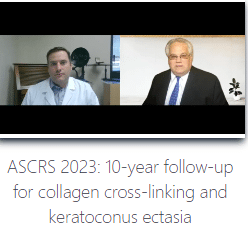
Dr. Steven Greenstein, a prominent ophthalmologist at the Cornea and Laser Eye Institute, recently shared his remarkable findings on the 10-year follow-up for cornea cross linking and its outcomes at the ASCRS annual meeting. In a compelling interview with Ophthalmology Times, he provided valuable insights into his presentation titled “10-year Followup for Corneal Cross-linking and Keratoconus Ectasia: Comparison of Outcomes with Subsequent Topography-altering Surgery.”
Below we cover the highlights of this interview, uncovering the significant implications for the long-term stability of corneal cross-linking in the treatment of keratoconus and ectasia.
Understanding the Study:
Dr. Greenstein’s study aimed to assess the stability of corneal cross linking by comparing the outcomes of patients who received cross-linking alone with those who underwent subsequent topography-guided procedures, such as corneal inlays or excimer procedures. The research focused on evaluating vision stability and corneal topography changes over a 10-year period following the initial treatment.
Key Findings:
Within the total cohort of patients, consisting of 29 eyes involved in the original pivotal cross-linking trials leading to FDA approval, an impressive 86% of patients maintained stable vision. Notably, all keratoconus patients in the study exhibited stability of their glasses vision, while approximately 71% of patients with ectasia demonstrated stable visual outcomes. Analysis of corneal topography revealed that around 75% of patients experienced sustained stability over ten years.
Comparison between Cross-Linking and Subsequent Surgery:
One aspect of the study involved comparing the outcomes of patients who underwent cross-linking alone with those who received additional topography-guided procedures. There was no statistically significant difference between stability in these two groups.
Differentiating Keratoconus and Ectasia:
Dr. Greenstein’s research emphasized an important distinction in the stability of keratoconus and ectasia patients. While both groups experienced notable improvements with corneal cross-linking, it was observed that keratoconus eyes exhibited higher stability compared to ectasia eyes. This finding underscores the importance of personalized counseling and close monitoring for patients with ectasia, especially those who have undergone LASIK. Approximately one-third of ectasia patients exhibited signs of progression over the 10-year period, highlighting the need for vigilant post-cross-linking monitoring.
Clinical Implications:
The study’s findings carry significant implications for both ophthalmologists and patients. Patients undergoing corneal cross-linking should be well-informed about the necessity of continued monitoring for progression, even after the initial procedure. Notably, repeat cross-linking can serve as a superior alternative to more invasive treatments like corneal transplant.
Furthermore, the research underscores the importance of early detection and proactive management of keratoconus and ectasia. Identifying these conditions at their early stages allows for timely treatment, potentially mitigating the need for additional surgical interventions down the line.
Conclusion:
Dr. Steven Greenstein’s interview with David Hutton of Ophthalmology Times provided valuable insights into the 10-year follow-up of corneal cross-linking for keratoconus and ectasia. His research highlights the long-term stability achieved through this non-invasive treatment approach. By emphasizing the need for ongoing monitoring and personalized care, ophthalmologists can optimize outcomes and minimize the need for more invasive interventions. These findings pave the way for enhanced patient education and improved treatment strategies, ultimately enhancing the quality of life for individuals affected by keratoconus and ectasia.




